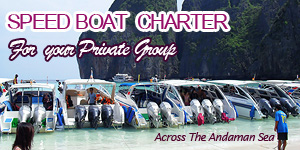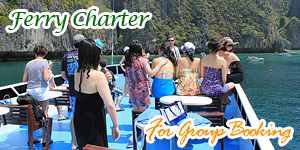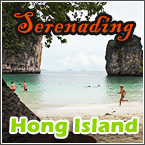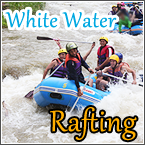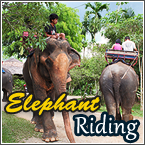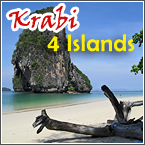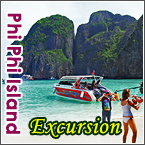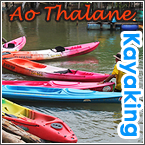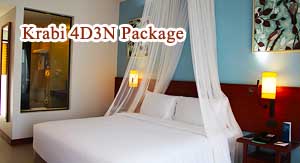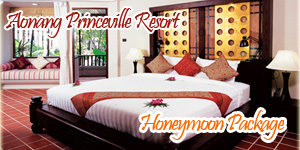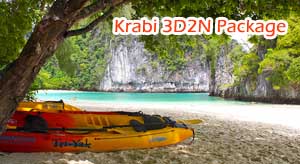Koh Lanta
July 13, 2009 by admin
Filed under Attractions
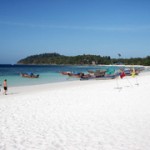
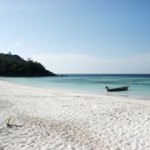
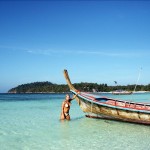
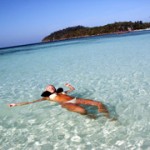
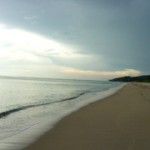 Koh Lanta, 68 km from Krabi town, has a group of 52 islands, the largest of which are Koh Lanta Yai, Koh Lanta Noi and Koh Klarng. ‘Pulaotatak’ is the original name for Koh Lanta. In the language of the Chao Ley sea gypsies, it means simply ‘island with long beach’. The Chao Ley have a long history of living in Koh Lanta. Although many Chao Ley today seem to live no differently from the ethnic Thais on Lant, they proudly keep alive some traditions, such as the celebration of ‘Loy Rua Chao Le’ (The setting adrift of the Chao Ley boats). Visitors wanting to learn more about the Chao Ley sea
Koh Lanta, 68 km from Krabi town, has a group of 52 islands, the largest of which are Koh Lanta Yai, Koh Lanta Noi and Koh Klarng. ‘Pulaotatak’ is the original name for Koh Lanta. In the language of the Chao Ley sea gypsies, it means simply ‘island with long beach’. The Chao Ley have a long history of living in Koh Lanta. Although many Chao Ley today seem to live no differently from the ethnic Thais on Lant, they proudly keep alive some traditions, such as the celebration of ‘Loy Rua Chao Le’ (The setting adrift of the Chao Ley boats). Visitors wanting to learn more about the Chao Ley sea 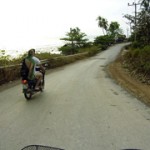 gypsies and their traditions should take a look at the village of Sangaua on the southernmost tip of Koh Lanta Yai’s West coast. Koh Lanta Yai’s geography consists mainly of limestone mountain, with the Lanta Range running through the middle of the island. It is covered in lush rainforest, home to many species of fauna and flora. The magnificent beaches of the West coast draw increasingly more travellers in search of rest and recreation. The sub-district of Saladan on Koh Lanta Yai is the center of tourist facilities. Some of the most popular activities on Koh Lanta are swimming, sunbathing, cave exploration and scuba diving.
gypsies and their traditions should take a look at the village of Sangaua on the southernmost tip of Koh Lanta Yai’s West coast. Koh Lanta Yai’s geography consists mainly of limestone mountain, with the Lanta Range running through the middle of the island. It is covered in lush rainforest, home to many species of fauna and flora. The magnificent beaches of the West coast draw increasingly more travellers in search of rest and recreation. The sub-district of Saladan on Koh Lanta Yai is the center of tourist facilities. Some of the most popular activities on Koh Lanta are swimming, sunbathing, cave exploration and scuba diving.
Laem Kor Kwang, with some accommodation available, is one of Lanta’s best beaches for swimming, and offer spectacular, panoramic views of the West coast. Klong Dao, near to Saladan village, is a 2 km long beach with the highest concentration of bungalows. When the tide is low, the beach gains an additional 300 m. Klong Nin Beach has a sunset that is second to none. Its predominant features are limjiak trees lining the sand dunes and rocks scattered randomly on the beach. Klong Jark Beach is one of Lanta’s smallest beaches at 400 m long. It is most famous for its pretty waterfall, 1.5 km inland, which flows all year round. It is advisable best to visit this waterfall with a local guide. The Koh Lanta National Park’s office, located near to Laem Tanode, has an excellent viewpoint. Hikers will enjoy a 2.5 km footpath passing the cliff and overlooking the sea. Laem Tanode and Hin Nagam Beach is where the Koh Lanta National Park headquarters are situated. It is also the site of a camping facility. From the lighthouse you can see Koh Rok and Phi Phi Ley Island. There are various natural attractions everywhere you look in Koh Lanta : mountains, forests, caves, streams, beaches and the sea. Rainforest covers the southernmost part of Lanta and Ngai Island. ‘Pulaotatak’ is the original name for Koh Lanta. In the language of the Chao Ley sea gypsies, it means simply ‘island with long beach’. The Chao Ley have a long history of living in Koh Lanta. Although many Chao Ley today seem to live no differently from the ethnic Thais on Lant, they proudly keep alive some traditions, such as the celebration of ‘Loy Rua Chao Le’ (The setting adrift of the Chao Ley boats). Visitors wanting to learn more about the Chao Ley sea gypsies and their traditions should take a look at the village of Sangaua on the southernmost tip of Koh Lanta Yai’s West coast. Koh Lanta Yai’s geography consists mainly of limestone mountain, with the Lanta Range running through the middle of the island. It is covered in lush rainforest, home to many species of fauna and flora. The magnificent beaches of the West coast draw increasingly more travellers in search of rest and recreation. The sub-district of Saladan on Koh Lanta Yai is the center of tourist facilities. Some of the most popular activities on Koh Lanta are swimming, sunbathing, cave exploration and scuba diving. Laem Kor Kwang, with some accommodation available, is one of Lanta’s best beaches for swimming, and offer spectacular, panoramic views of the West coast.
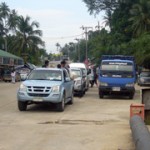
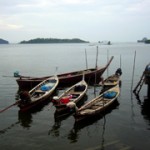
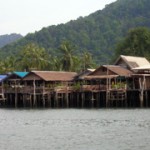
Klong Dao, near to Saladan village, is a 2 km long beach with the highest concentration of bungalows. When the tide is low, the beach gains an additional 300 m. Klong Nin Beach has a sunset that is second to none. Its predominant features are limjiak trees lining the sand dunes and rocks scattered randomly on the beach. Klong Jark Beach is one of Lanta’s smallest beaches at 400 m long. It is most famous for its pretty waterfall, 1.5 km inland, which flows all year round. It is advisable best to visit this waterfall with a local guide. The Koh Lanta National Park’s office, located near to Laem Tanode, has an excellent viewpoint. Hikers will enjoy a 2.5 km footpath passing the cliff and overlooking the sea. Laem Tanode and Hin Nagam Beach is where the Koh Lanta National Park headquarters are situated. It is also the site of a camping facility. From the lighthouse you can see Koh Rok and Phi Phi Ley Island. There are various natural attractions everywhere you look in Koh Lanta : mountains, forests, caves, streams, beaches and the sea. Rainforest covers the southernmost part of Lanta and Ngai Island.
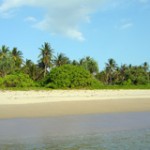
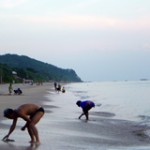
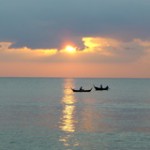
WHERE TO STAY ON KOH LANTA
There are accommodation facilities on both side of the road in Saladan Village, as well as near the beach. Some examples of resorts with relaxed surroundings and reliable services, are Southern Lanta Resort, Goodday Lanta Challey Resort, Lanta Palace and the Narima Resort. The most luxurious of all is Pimilai Resort and Spa.
WHERE TO EAT ON KOH LANTA
Food and shopping on Koh Lanta is normally expensive, due to the high costs of transportation from the main markets of supply in Krabi town. However, restaurants are well stocked to serve all the usual demands of Thai and international menus. One restaurant located in the centre of Koh Lanta is Same Same But Different. It is well presented in a smart European style, and boasts a spectacular sunset over the Beach in the West.
FACILITIES ON KOH LANTA
If you are new to Koh Lanta, you will find the best tourist information services in Saladan Village. The travel agents here offer internet services, car, motorbike and boats rentals, and a complete range of organized tours by sea and land. Saladan also has money exchanges, ATMs and souvenir shops. There is also a hospitals, a few steps away from Koh Lanta’s district office.
KOH ROK
It is probably clear by now that much of Lanta can be considered a marine park, with many tiny islands. Wildlife abounds with sightings of wild pigs, langurs, mice, deer, civets and squirrels. Reptile species include the yellow tree monitor. There are literally hundreds of migrant and native bird species. But the sea provides Lanta with the richest ecosystem of all, including some legends of the sea, whale sharks and manta rays, occasionally frequent the waters. The islands of Koh Rok and Koh Ha both have limestone karsts, forests and groves scattered around the beaches. Talengbeng Island is a rocky, limestone island, East of Lanta Yai and resembles the more famous Phi Phi Ley Island. A great number of swifts build their homes on the island, especially inside one cave, which is exposed at low tide. Ngai Island is a must for a day trip. It has very fine, white powdered sands, and the shallow water corals, suitable for snorkeling, make for fascinating discoveries. There is only one house on the island, but several private resorts and restaurants to choose from. The East coast of Koh Rok Nai is a sandy beach with more shallow water corals for snorkeling. The West coast of the same island is a cliff with deeper waters, preferred by divers, Koh Rok Nok has a horse shoe bay called Ao Talu, again with fine, powdery sands. Marnsai Beach is another good spot for snorkeling , and some accommodation. The 1.5 km nature trail on the island is an interesting challenge. Koh Ha (Tugnalima Island) is part of a group of 5 rocky isands, offering very picturesque scenery.
HOW TO GET TO KOH LANTA
There are daily boat and minibus services running between Krabi town and Koh Lanta, the conecting piers being Chao Fa in Krabi town and Saladan on Koh lanta. there is also a short boat ride across from the mainland at Bor Muang in Klong Tom Tai district. Car drivers should use the car ferry at Ban Hua Hin to Koh Lanta Noi, where there are connecting ferries.
HOW TO GET TO KOH NGAI, KOH ROK, HIN MUANG & HIN DAENG
Private boats can be rented from Saladan Village. For scuba divers, there are regular trips to Hin Daeng, Hin Muang and Koh Ha.
Source : Krabi Tourism Association
Motoring Over Koh Lanta
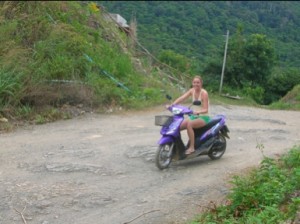 Thailand… Are we nuts?! Nah: The airport trouble is over, and while politicians keep bickering in Bangkok, the rest of the country is ripe for exploration. Claire Duffett just spent two weeks in southwest Thailand sailing the Andaman Sea from Krabi to Phuket. Koh Lanta offers the beauty of the Andaman Sea with fewer crowds because the large size of this island helps it absorb everyone. Head south through the national park and prepare to stabilize your breathing: The beaches down there are magnificent, as is the scenery along the winding, pothole-covered roads. Here’s the catch: None of this is within walking distance of the nearest towns, and even the resorts down in the more rustic areas of the island require motorized transport. The solution? Hire a moto driver, or, if you’re brave enough, rent one and navigate the island yourself. For 250 baht (about $7), plus gas, two pals can rent a motorbike and traverse the island in a single day. First, stop in the port town for supplies: Check your email at less inflated prices than you’ll find elsewhere and maybe pick up a Frisbee for some beach-side action. Escape quickly, though, because this area is the only place on the island where the stain of sun seekers is significant. If you’re into a day of sarong and cheap sunglasses shopping, however, hang around. The Old Town blows the tacky port area out of the crystal-clear water. Spread along the island’s mangrove-forested eastern side, has an eerie Old West feel to it with dark wooden, clapboard homes sitting on stilts over the water. I counted one solitary yuppie Western restaurant while all the other places seemed like authentic Chinese-Thai haunts, with all the delicious food and kitschy atmosphere that comes with. Further south along the island’s easternmost road is one of the so-called sea gypsy villages. Because the area hasn’t turned into a tourist attraction, it just looks like a typical village, with dogs, chickens and beautiful children running around while women prepare meals in houses painted exceptionally bright colors. There’s also a Monkey School and a Cobra Show on the northern portion of the road. But since I’ve been suckered into those kinds of adventures before and always left feeling guilt-stricken and abused, I skipped them. I’d recommend sticking to the southern portion of the island in general, where the terrain is beautiful, the population sparse and the roads windy. Several restaurants have porches that offer sweeping ocean views. Look for parked motorbikes along the roadside to find hidden paths to quiet beaches. Motoring around the island can become a multi-day project, though Lanta offers other activities. It has two cooking schools, the pricier, foreign-owned A Time for Lime, which offers beautiful beach-side facilities and an expansive menu; the cheaper and locally-owned Lanta Cooking School taught us how to make the best-damned Panang curry ever. At night, Ting Tong Bar–ting-tong is Thai slang meaning “nutty”–near the beach’s northern end has the liveliest scene. Chill out alongside afro-ed Thais who fire dance and love themselves some Bob Marley.
Thailand… Are we nuts?! Nah: The airport trouble is over, and while politicians keep bickering in Bangkok, the rest of the country is ripe for exploration. Claire Duffett just spent two weeks in southwest Thailand sailing the Andaman Sea from Krabi to Phuket. Koh Lanta offers the beauty of the Andaman Sea with fewer crowds because the large size of this island helps it absorb everyone. Head south through the national park and prepare to stabilize your breathing: The beaches down there are magnificent, as is the scenery along the winding, pothole-covered roads. Here’s the catch: None of this is within walking distance of the nearest towns, and even the resorts down in the more rustic areas of the island require motorized transport. The solution? Hire a moto driver, or, if you’re brave enough, rent one and navigate the island yourself. For 250 baht (about $7), plus gas, two pals can rent a motorbike and traverse the island in a single day. First, stop in the port town for supplies: Check your email at less inflated prices than you’ll find elsewhere and maybe pick up a Frisbee for some beach-side action. Escape quickly, though, because this area is the only place on the island where the stain of sun seekers is significant. If you’re into a day of sarong and cheap sunglasses shopping, however, hang around. The Old Town blows the tacky port area out of the crystal-clear water. Spread along the island’s mangrove-forested eastern side, has an eerie Old West feel to it with dark wooden, clapboard homes sitting on stilts over the water. I counted one solitary yuppie Western restaurant while all the other places seemed like authentic Chinese-Thai haunts, with all the delicious food and kitschy atmosphere that comes with. Further south along the island’s easternmost road is one of the so-called sea gypsy villages. Because the area hasn’t turned into a tourist attraction, it just looks like a typical village, with dogs, chickens and beautiful children running around while women prepare meals in houses painted exceptionally bright colors. There’s also a Monkey School and a Cobra Show on the northern portion of the road. But since I’ve been suckered into those kinds of adventures before and always left feeling guilt-stricken and abused, I skipped them. I’d recommend sticking to the southern portion of the island in general, where the terrain is beautiful, the population sparse and the roads windy. Several restaurants have porches that offer sweeping ocean views. Look for parked motorbikes along the roadside to find hidden paths to quiet beaches. Motoring around the island can become a multi-day project, though Lanta offers other activities. It has two cooking schools, the pricier, foreign-owned A Time for Lime, which offers beautiful beach-side facilities and an expansive menu; the cheaper and locally-owned Lanta Cooking School taught us how to make the best-damned Panang curry ever. At night, Ting Tong Bar–ting-tong is Thai slang meaning “nutty”–near the beach’s northern end has the liveliest scene. Chill out alongside afro-ed Thais who fire dance and love themselves some Bob Marley.
An excerpt posted by ced138
December 10, 2008
RELATED ARTICLE : Life In A Sea Gypsy Village.






